Practice with indexing
Let’s write some functions that practice what we’ve learned with indexing into lists.
Where’s Waldo?
You have a list of names. Write a function that returns the index of ‘Waldo’. Return None if Waldo is not present.
def wheres_waldo(names):
pass
wheres_waldo(['Juan','William','Wally','Waldo','Wilford','Winston'])Here is a flow chart for this algorithm:
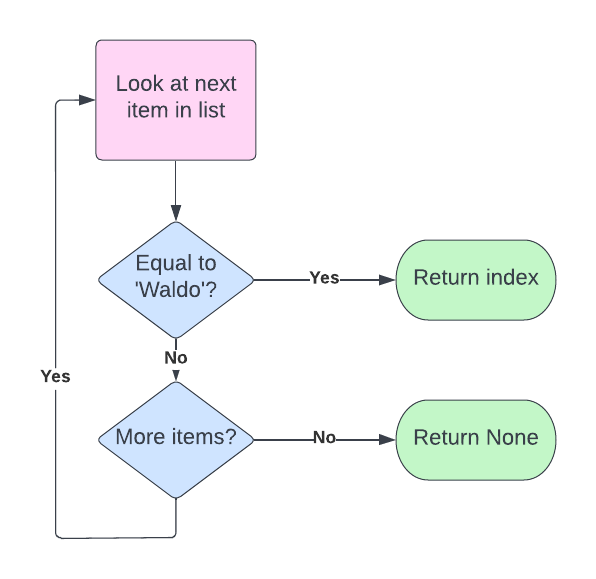
Putting this into words:
- for each string in the list
- check if the string is equal to ‘waldo’
- if it is, return the index
- return None by default
Here is now that translates into code:
def wheres_waldo(names):
for index in range(len(names)):
if names[index] == 'Waldo':
return index
return NoneMiddles
Find all positions in a list where the value is greater than the value on the left and less than the value on the right.
The first and last positions do not have neighbors on both sides and should not be part of the output.
def find_middle_positions(items):
return []
numbers = [1, 5, 3, 7, 8, 2, 3, 4, 6, 9, 0, 2, 7]
find_middle_positions(numbers)Try drawing a flow chart on your own.
Here is a flow chart:
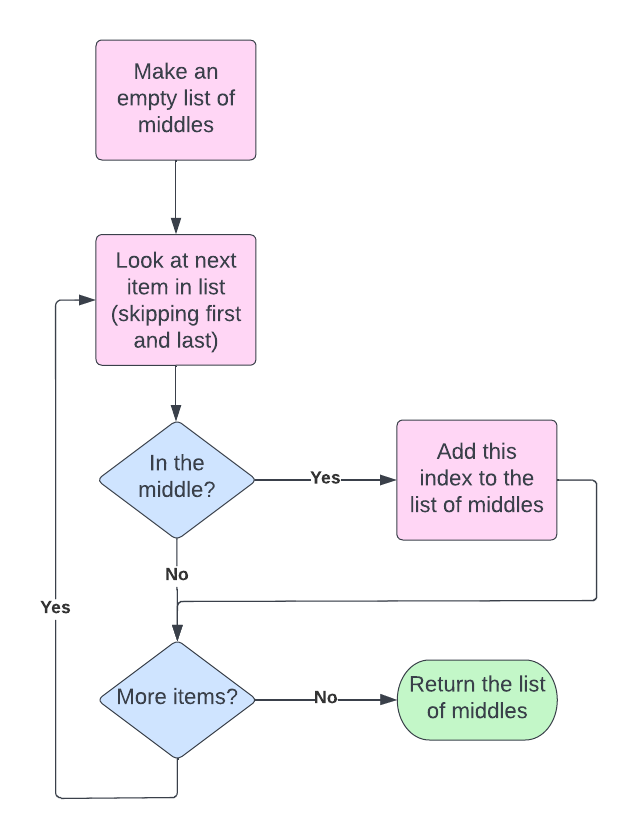
And here is this algorithm in English:
-
make an empty list of middles
-
for each item in the list (except first and last)
- is it in the middle?
- add it to the list of middles
- is it in the middle?
-
return the list of middles
Finally, here is some code that implements this algorithm:
def find_middle_positions(items):
middles = []
for index in range(1, len(items) - 1):
if items[index] > items[index - 1] and items[index] < items[index + 1]:
middles.append(index)
return middlesRoll over
Given a list, shift every item to the left. The right-most item becomes None. Return the left-most item.
For example:
roll_over(['Mary', 'May', 'Michelle', 'Mykala'])This should return Mary and the list should now contain
['May', 'Michelle', 'Mykala', None].
It helps to draw this out:
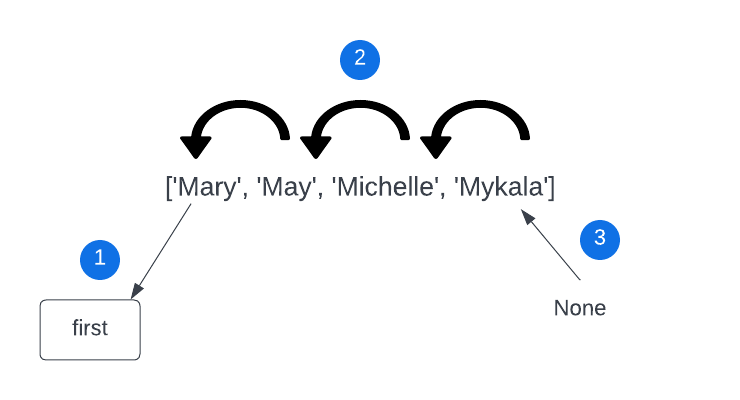
In step (1) we save the first item into a variable called first. In step (2)
we shift items to the left. In step (3) we put None into the last spot. At the
end, we can return first.
Here is how we can translate that into code:
def roll_over(items):
# keep track of first item
first = items[0]
# Shift everyone else left
for index in range(len(items)-1):
items[index] = items[index + 1]
# Put a None at the end
items[-1] = None
return firstNotice that for the range we count from 0 to len(items) - 1. This is because
we need item 1 to move into position 0, item 2 into position 1 and so
forth. If we have a list of length 4, and we try to move item 4 into
position 3 — there is no item `4 and this will cause an error! You can see
how this follows from the diagram above.
Now if we call this code:
names = ['Mary', 'May', 'Michelle', 'Mykala']
print(roll_over(names))
print(names)We will get:
Mary
['May', 'Michelle', 'Mykala', None]Rotate right
Given a list, shift every item to the right one space. Items on the end wrap around to the front.
This is similar to the above problem. Let’s draw it out:
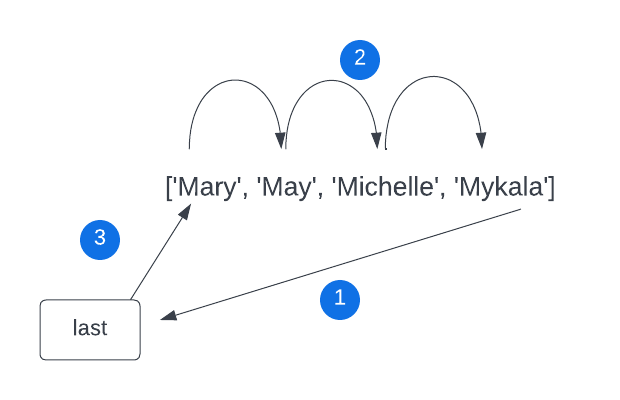
In step (1) we save the last item into a variable called last. In step (2) we
shift items to the right. In step (3) we put last into the first spot. We
don’t need to return anything.
Here is this algorithm in code:
def rotate_right(items):
"""Shift the items one space to the right. Wrap the item on the end around to the front.
Modifies the input list.
"""
last = items[-1]
for index in range(1, len(items)):
destination = len(items) - index
items[destination] = items[destination - 1]
items[0] = lastNotice that we need to be careful about how we shift items. If we shift the first item into the second spot, then the second spot is overwritten before it is moved! So we have to move the second-to-last item into the last spot, and then the third-to-last item into the second-to-last-item, and so forth.
We do this by creating a variable called destination that is set to
len(items) - index. This will make the destination the last item the first
time through the loop, then the second-to-last item, etc. We move whatever is in
destination - 1 into destination.
We can call this code as follows:
pets = ['fish', 'dog', 'cat', 'gerbil', 'gecko', 'salamander', 'parakeet']
rotate_right(pets)
print(pets)and this will print:
['parakeet', 'fish', 'dog', 'cat', 'gerbil', 'gecko', 'salamander']Sorted sequence
A sorted sequence is a series of numbers in consecutive positions in a list that are in order. For example, this is a sorted sequence:
1, 5, 8We want to write a function tells us whether a list of numbers contains a sorted sequence of a given size. For example,
numbers = [1, 2, 5, 4, 8, 3, 6, 7, 9, 1]
sorted_sequence(numbers, 4)This should return True because we can find [3, 6, 7, 9] — a sequence of 4
numbers that is sorted.
This function takes two parameters:
def has_sorted_sequence(items, size):
passHere is a flow chart for this problem:
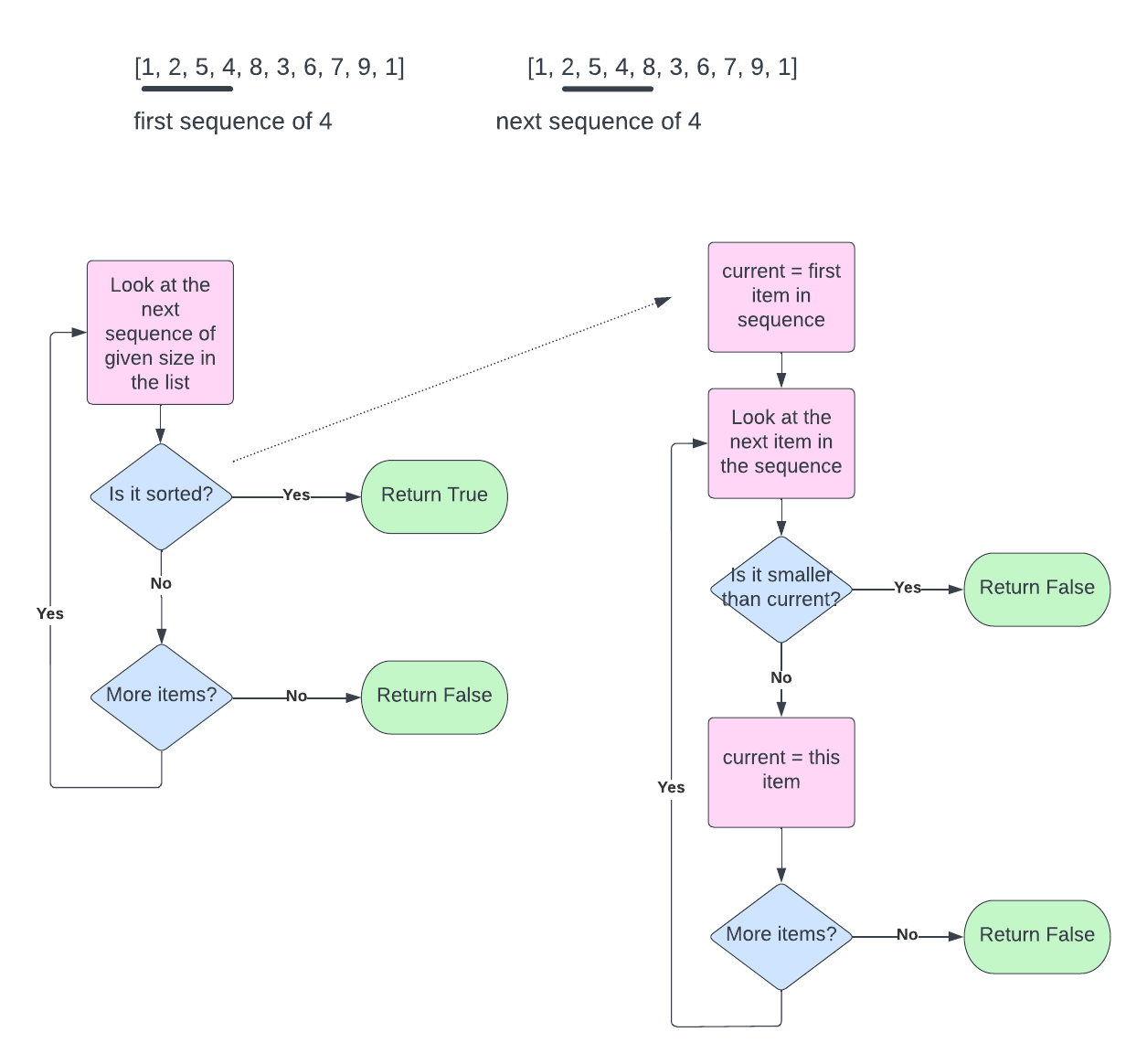
The top part shows that we need to go through a list of numbers and look at
every sequence of the requested size. Here we show what you would do if size
is 4.
The left side shows a flow chart for the overall problem. We go through each sequence of the requested size, and check if it is sorted. If we find a sorted sequence, we immediately return True. Otherwise, we keep looping.
The right side shows a flow chart for checking if a sequence is sorted. We set
current equal to the first item. Then we loop through all of the rest of the
items. If we find an item that is smaller than current, we return False.
Otherwise we set current equal to the current item. By default we return True.
We can write a separate function for each side of the flow chart.
Code for the left side
Here is code for the left side:
def has_sorted_sequence(items, size):
"""Returns True if the list contains a sorted sequence of length `size`."""
for index in range(len(items) + 1 - size):
if is_sorted_sequence(items, index, size):
return True
return FalseOur range goes from 0 to len(items) + 1 - size. Look at the example at the
top of the flow chart. We have 10 items and we want to check if there is a
sorted sequence of length 4. Then we need to check the first 4 items, the next
four items … and we have to do this 7 times. The number of times we need to
loop is equal to the length of the list (10), plus 1, minus the size (4) — 10 +
1 - 4 = 7.
Code for the right side
Here is the code for the right side:
def is_sorted_sequence(items, index, size):
"""Returns True if the list contains a sorted sequence of length `size` starting at position `index`."""
for i in range(index + 1, index + size):
if items[i] < items[i-1]:
return False
return TrueWe are given a list of items, an index, and a size. Imagine that we have this parameters:
| items | index | size |
|---|---|---|
| [1, 2, 5, 4, 8, 3, 6, 7, 9, 1] | 1 | 4 |
By using range(index + 1, index + size), we are looping from the 2nd number in
this sequence to the last. We then check if any item in the sequence is less
than the item before it.
| i | items[i] | items[i - 1] | Less? |
|---|---|---|---|
| 2 | 5 | 2 | No |
| 3 | 4 | 5 | Yes |
So we return False.
Eventually we call this function with:
| items | index | size |
|---|---|---|
| [1, 2, 5, 4, 8, 3, 6, 7, 9, 1] | 5 | 4 |
And we have:
| i | items[i] | items[i - 1] | Less? |
|---|---|---|---|
| 6 | 6 | 3 | No |
| 7 | 7 | 6 | No |
| 8 | 9 | 7 | No |
So we return True — we found a sorted sequence.